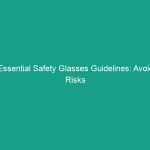Introduction
In the construction industry, workplace Safety is not just a regulatory requirement but a fundamental aspect that ensures the well-being of employees. The importance of Health, Safety, and Environment (HSE) practices cannot be overstated, especially when it comes to preventing injuries. Among the most common injuries in this sector are musculoskeletal disorders (MSDs), which can significantly impact workers’ health and productivity. This article focuses on the prevention of musculoskeletal disorders in construction, providing essential tips and insights that can help mitigate these risks effectively.
Understanding Musculoskeletal Disorders
Musculoskeletal disorders encompass a wide array of conditions that affect the muscles, bones, and joints. In construction, these injuries often arise from repetitive movements, Manual Handling of heavy loads, or poor posture during tasks. They can lead to chronic pain, decreased mobility, and even long-term disability if not addressed promptly. The prevention of musculoskeletal disorders in construction involves understanding the risk factors and implementing strategies to minimize exposure to these Hazards.
Common Types of Musculoskeletal Disorders
In the construction industry, some of the most prevalent musculoskeletal disorders include:
- Back injuries: Often caused by lifting heavy materials or awkward postures.
- Carpal tunnel syndrome: Resulting from repetitive hand movements, such as operating power tools.
- Tendinitis: Inflammation of tendons due to overuse, commonly affecting the elbows and shoulders.
- Rotator cuff injuries: Caused by repetitive overhead work or heavy lifting.
Regulatory Framework for HSE in Construction
The construction industry is governed by numerous Regulations aimed at ensuring Safety and health Standards are met. Understanding these regulations is crucial for implementing effective Prevention strategies for musculoskeletal disorders.
Occupational Safety and Health Administration (OSHA) Guidelines
osha sets forth regulations that require construction employers to provide a safe work environment. This includes addressing ergonomic Hazards that can lead to MSDS. Compliance with OSHA guidelines not only protects workers but also shields employers from legal repercussions and potential financial losses due to workplace injuries.
European Agency for Safety and Health at Work (EU-OSHA) Initiatives
In Europe, EU-OSHA promotes awareness and prevention of workplace risks, including musculoskeletal disorders. Their campaigns often focus on ergonomic practices and the importance of workplace assessments to identify potential hazards. Employers are encouraged to engage in proactive measures, such as Training and ergonomic interventions.
Best Practices for Prevention of Musculoskeletal Disorders in Construction
Implementing Best Practices is essential for the prevention of musculoskeletal disorders in construction. These practices not only enhance worker safety but also improve overall productivity and reduce absenteeism.
Ergonomic Assessments
Conducting regular ergonomic assessments can help identify tasks that pose a high risk for MSDs. These assessments should evaluate the work environment, tools, and techniques used by workers. Key areas to focus on include:
- Workstation design and layout
- Weight limits for lifting
- Frequency of repetitive tasks
Training and Education
Providing training for workers on proper lifting techniques, the use of Personal Protective Equipment (PPE), and recognizing early symptoms of musculoskeletal disorders is vital. Training should be ongoing and tailored to the specific tasks performed on the job site. Employers should emphasize the importance of reporting discomfort or pain early to prevent chronic issues.
Administrative Controls
Employers can implement administrative controls to reduce the risk of MSDs, such as:
- Job rotation to minimize repetitive strain on specific muscle groups.
- Adjusting work schedules to allow for breaks and recovery.
- Encouraging a culture of safety where workers feel comfortable discussing their concerns.
Use of Technology and Tools
Modern technology can play a significant role in reducing the incidence of musculoskeletal disorders. Utilizing lifting devices, ergonomic tools, and advanced machinery can alleviate the physical burden on workers. For instance, using powered lifts for heavy materials eliminates the need for manual lifting, significantly lowering the risk of back injuries.
Case Studies: Successful Implementation of Prevention Strategies
Examining successful case studies can provide valuable insights into effective strategies for the prevention of musculoskeletal disorders in construction.
Case Study 1: XYZ Construction Company
XYZ Construction Company implemented a comprehensive ergonomic program after noticing a rise in MSD-related claims. They conducted ergonomic assessments and invested in training sessions for their employees. As a result, the company reported a 30% decrease in MSD injuries within the first year, significantly improving worker morale and productivity.
Case Study 2: ABC Builders
ABC Builders adopted a job rotation strategy to combat repetitive strain injuries. By rotating workers through different tasks, they found that not only did injuries decrease, but overall job satisfaction increased. Workers appreciated the variety in their roles, reducing fatigue and boredom.
Challenges in the Prevention of Musculoskeletal Disorders in Construction
Despite the best efforts to prevent musculoskeletal disorders, several challenges remain prevalent in the construction industry.
Resistance to Change
One of the significant hurdles is the resistance to change among workers and management. Many employees are accustomed to traditional methods of working and may be reluctant to adopt new ergonomic practices. Overcoming this resistance requires strong leadership and effective communication about the Benefits of these changes.
Limited Resources
For smaller construction firms, financial constraints may limit the ability to implement comprehensive safety programs. Investing in ergonomic tools and training can be seen as an added expense, leading to hesitation. However, emphasizing the long-term cost savings from reduced injuries can help justify these expenditures.
Lack of Awareness
Many workers may not be aware of the risks associated with their tasks or the importance of prevention strategies. Continuous education and awareness campaigns are crucial to ensure that all employees understand the significance of their safety and health.
Future Trends in HSE and Musculoskeletal Disorder Prevention
The future of HSE practices, particularly regarding the prevention of musculoskeletal disorders in construction, is evolving with advancements in technology and increasing awareness of Workplace Safety.
Integration of Wearable Technology
Wearable technology is emerging as a game-changer in monitoring worker health and safety. Devices that track posture, movements, and physical strain can provide real-time feedback to workers and supervisors, allowing for immediate corrective actions to prevent injuries.
Increased Focus on Mental Well-being
Recognizing the link between physical and mental health is becoming increasingly important. Construction companies are beginning to implement programs that address mental well-being, which can indirectly impact physical health and reduce the risk of MSDs.
Conclusion
The prevention of musculoskeletal disorders in construction is a critical component of ensuring a safe and productive work environment. By understanding the risks, complying with regulatory frameworks, and implementing Best Practices, construction companies can significantly reduce the incidence of these disorders. Continuous education, innovative technology, and a commitment to safety culture are vital to achieving lasting improvements. As an employer or employee, take proactive steps to prioritize your health and safety on the job. Together, we can build a safer construction industry.


